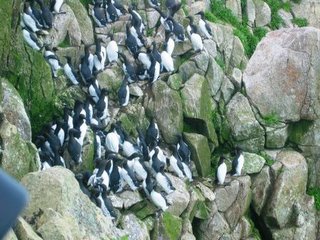 Every summer, these beautiful birds raise a single chick on crowded colonies like this one on Shubrick Point. When the chicks are old enough to swim, their fathers take them to sea to teach them how to fish for themselves. The mothers disperse to fatten up in preparation for the next year's breeding effort.
Every summer, these beautiful birds raise a single chick on crowded colonies like this one on Shubrick Point. When the chicks are old enough to swim, their fathers take them to sea to teach them how to fish for themselves. The mothers disperse to fatten up in preparation for the next year's breeding effort.  After a few months apart, the adults reconvene on the Farallones on certain days when the winds and weather are just right. Murres form lifelong monogamous breeding pairs and breed each year at the same nest site, so these winter reunions are when they come together after months apart at sea and reacquaint themselves with each other and their nest sites. They also raft up into huge feeding flocks all around the island where they feed by flying underwater after their prey of juvenile rockfish, sardines, and anchovies.
After a few months apart, the adults reconvene on the Farallones on certain days when the winds and weather are just right. Murres form lifelong monogamous breeding pairs and breed each year at the same nest site, so these winter reunions are when they come together after months apart at sea and reacquaint themselves with each other and their nest sites. They also raft up into huge feeding flocks all around the island where they feed by flying underwater after their prey of juvenile rockfish, sardines, and anchovies. The extremely productive waters of the Gulf of the Farallones provides a bounty that supports a richness, diversity and abundance of marine animals on the Farallon Islands that is unrivalled in the contiguous United States. It is hard to comprehend the riot of life that exists just outside the Golden Gate, in the midst of one of the busiest shipping areas in the country. The wildlife of California's Galapagos is under constant threat from human industry, and Murres are especially hard hit by the oil spills that too often punctuate our datasets. Help protect California's Galapagos, support PRBO Conservation Science today.
No comments:
Post a Comment